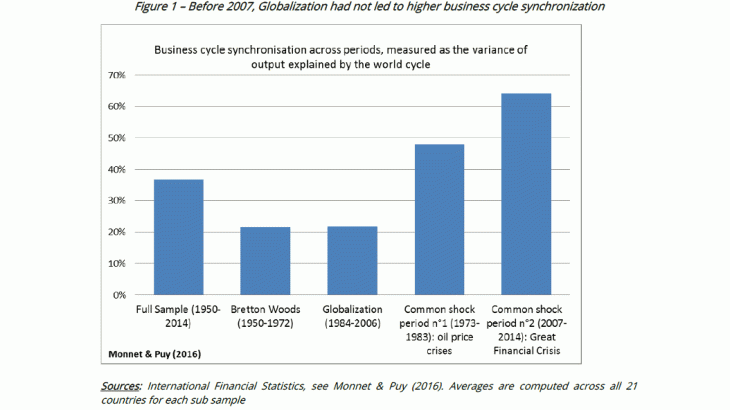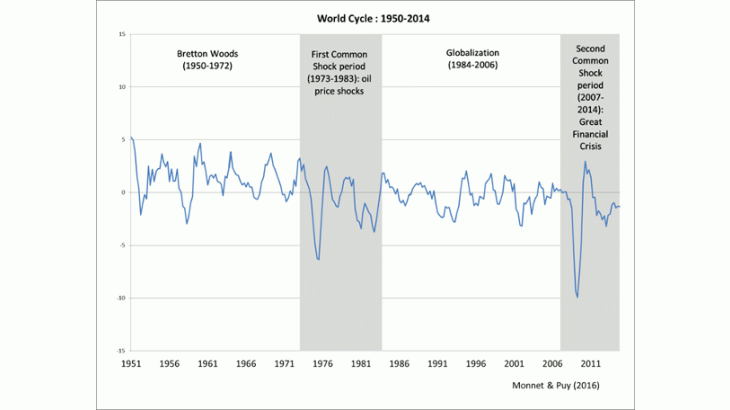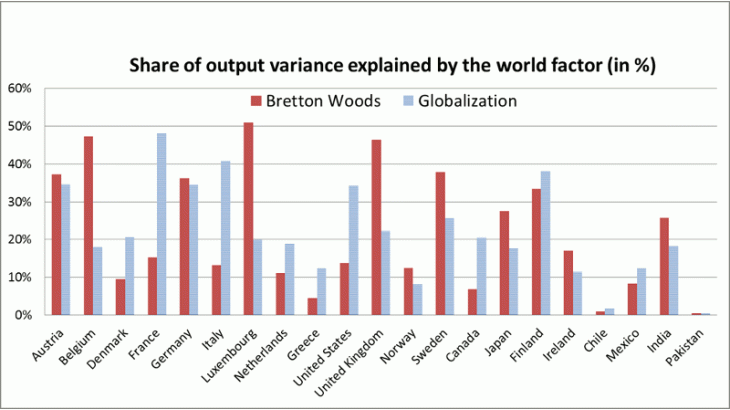- Home
- Publications et statistiques
- Publications
- Has globalization increased business cyc...
Post n°15. As the world economic growth is experiencing its first synchronized recovery since the 2007-2008 financial crisis, it is time to investigate again the links between business cycle synchronization and financial openness. Would decreasing international capital movements attenuate co-movements between national cycles? An historical perspective on the matter shows that, contrary to the common wisdom, the periods of lower global financial integration were not associated with lower business cycle synchronization.

At the IMF Spring meetings (April 20-22), policy makers will discuss recent forecasts pointing towards the first synchronous global recovery since 2010, even if updates are not upward everywhere. At the same time, prospects about the future of financial globalization are still a matter of debates, few years after the Great Financial Crisis. It is likely to spur new discussions on the links between financial openness and business cycles synchronisation at the world level (IMF, 2013). What can we expect from post-financial crisis globalized economies? In a recent paper (Monnet and Puy, 2016) we shed an historical perspective on the matter, using new quarterly data from the IMF archives since 1950. First, contrary to the common wisdom, we find that the Bretton Woods era (when international capital flows were limited) was not a period of low co-movement compared to the period between 1984 and 2006, which saw a massive rise in both trade and financial globalization. Thus, a low level of financial integration does not imply, per se, a low level of co-movement at the world level. Second, we find a negative link between financial openness and the correlation of a country’s cycle with the world business cycle – contrary to trade openness -, although the sign is reversed when the global financial crisis hit (i.e after 2007). Absent a global financial shock, and for a given country, a higher level of financial openness implies a lower level of business cycle synchronization.
The world factor –and its influence on national economies - since 1950
Although economic theory is still inconclusive as to the exact effect of integration on the properties of business cycle co-movement, a number of empirical contributions have argued that intense trade and financial integration is associated with a stronger degree of business cycle synchronization A corollary of this view is that the Bretton Woods era – a period during which capital controls were ubiquitous and both trade and financial integration were substantially below both pre-WWI and current levels (Obstfeld and Taylor 2004) – is often presented as the low point of business cycle synchronization in history (Kose, Otrok and Whiteman, 2008). But is it true that world co-moves more than it used to? And could it be that returning to the Bretton Woods world – with capital controls and fixed exchange rates – would decrease business cycle co-movement between countries?
Building on the approach of Kose, Otrok and Whiteman (2008) and a new database of real activity (industrial production) for 21 countries since 1950, our research first shows that a very precise (common) world factor has been at play since 1950, although its quantitative impact has varied significantly across periods (Figure 1 & 2). Following Kose, Otrok and Whiteman (2008), we first estimate a dynamic common factor (the “world common factor”) that reflects the common component of countries’ economic growth (Figure 2). We also show that the chronology of the estimated fluctuations of the world factor is corroborated by narrative evidence on what was discussed by contemporary economists in the IMF annual reports since 1950 (Monnet and Puy, 2016). Then, we compute the percentage of the volatility of a countries’ growth that is explained by the world factor. A high value of this percentage means that a country is very synchronized with the world cycle. The common factor and the variance decomposition are then reestimated and compared across sub-periods.
No differences between Bretton Woods and the Globalization period
Figure 1 shows the average (across countries), per period, of such a measure of synchronization. As expected, we find that the importance of the world factor for national output dynamics increases dramatically during periods of common shocks (1972-1983 and 2007-2014). For instance, we estimate that between 2007 and 2014, 65% of the variance in output growth in our sample was due to the world factor, suggesting that almost no country moved on its own during that period. Contrary to the common wisdom however, we do not find any difference in co-movement between Bretton Woods (1950-1971) and the Globalization Period (1984-2006). On average, the global dynamic accounts for 20% of output volatility in both periods. Among other things, this result shows that when a longer sample is used, we do not find empirical support for the view that Globalization, before the 2007-2008 financial crisis, was associated with more co-movement at the global level.

Source: Internationial Financial Statistics, see Monnet and Puy, 2016
Note: world factor estimated as a dynamic Bayesian factor
Why do some countries “de-synchronize” while others “re-synchronize”?
Another important finding of our study is that although the average co-movement we observe has not changed between Bretton Woods and the Globalization period, the identity of countries who co-moves with the rest of the world has changed substantially (Figure 3). Countries such as the UK, Belgium or Sweden, who were strongly co-moving with the rest of the world during Bretton Woods, have been significantly disconnected from the world dynamic during the Globalization period. In contrast, countries such as France, Italy and to a minor extent the US, who experienced a rather singular dynamic under Bretton Woods, have been re-synchronizing with the world cycle. A significant number of countries are also found to display constantly low (or high) degree of synchronization with the rest of the world in both periods.

Sources: International Financial Statistics, see Monnet and Puy, 2016.
Why do some countries synchronize while others de-synchronize? To answer this question, we simply estimate (with panel data) the determinants of the change across periods of a country’s synchronization with the rest of the world (Monnet and Puy, 2016). We find that the changes in synchronization observed over the last 65 years can be explained, to a great extent, by both trade and financial integration patterns. In normal times, we find that deeper financial integration has a negative impact on the synchronization with the world cycle. Quantitatively, we estimate that increasing financial integration by 10% – measured by the ratio of Foreign Assets plus Foreign Liabilities to GDP – decreases co-movement with the rest of the world by 1%. Interestingly, this “de-synchronizing” effect is compensated by opposite forces in times of global financial stress (e.g. since 2007), during which the most financially integrated economies co-move more than others. On the contrary, during the period of common shocks (1973-1984) which was due to oil prices rather than a global financial crisis, countries which were the most financially open did not move more with the rest of the world. Finally, we also find that trade integration tends to increase co-movement with the rest of the world. Hence trade integration and financial integration have opposite effects on the synchronization of a country’s output with the rest of the world.
Conclusion
The global financial and economic crisis reignited the debate on the importance of globalization in shaping output co-movements. Our research casts a new light on these issues in two ways. First, we find that the Bretton Woods era was not a period of low co-movement compared to the period between 1984 and 2006, which saw a massive rise in both trade and financial globalization. Among other things, this implies that a low level of integration – imposed through the extensive use of capital controls and trade barriers - does not imply, per se, a low level of co-movement in the international economic system. Second, we find a robust negative link between financial openness and the correlation with the world business cycle, although this effect is clearly reversed after 2007. Financial integration has a strong but asymmetric impact on output co-movement: it pushes down co-movement in normal times ( “risk sharing” or “portfolio rebalancing” effects dominate) but has increased it during the recent global financial crisis (the “contagion effect” dominates). This result echoes the recent empirical findings of the literature looking at correlations of country pairs: Kalemli-Ozcan, Papaioannou and Peydro (2013) also found such asymmetry, although they define shocks differently. It remains to be assessed whether the current aftermath of the global financial crisis will be associated with a new period of low synchronization and the return of the desynchronizing effects of financial openness.
N.B: a slightly different version of this blog post was previously published on VoxEU, under the title “Business cycle synchronisation and the Bretton Woods nostalgia”
Updated on the 25th of July 2024